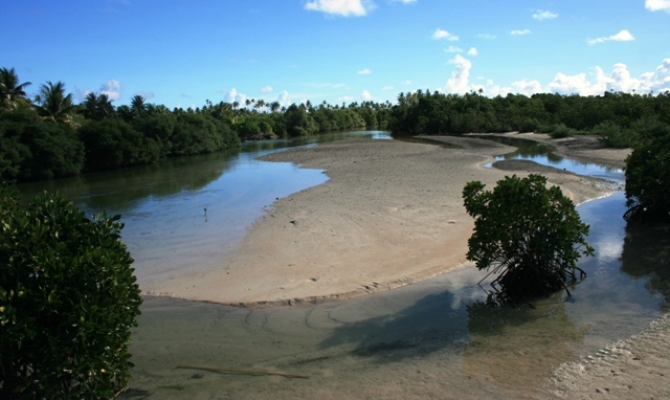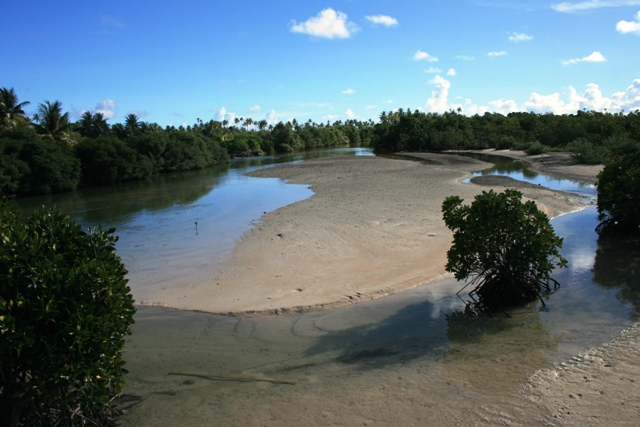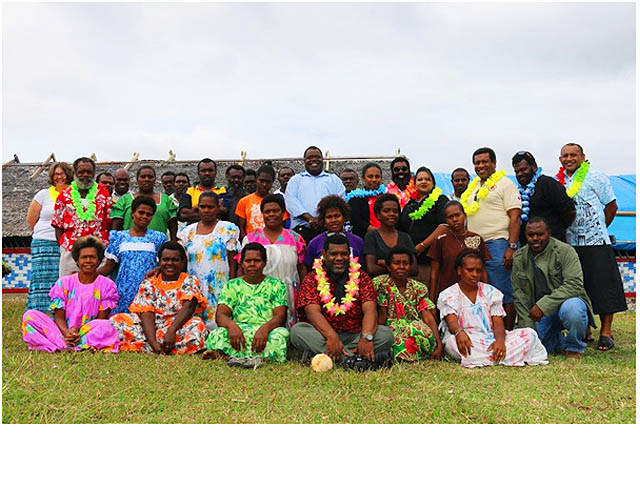
Island and Ocean Ecosystems
The annual observation of World Wetlands Day on the second day of February each year marks the day the Ramsar Convention on Wetlands was signed in the Iranian city of Ramsar in 1971. The event was first celebrated in 1997 and provides an opportunity to raise and strengthen awareness of the importance of wetlands throughout the world and in the Pacific region.
This year’s theme for World Wetlands Day – ‘Wetlands for our Future’ – highlights the vital importance of wetlands to the survival of humanity. It underpins the importance of keeping these ecosystems healthy and resilient into the future so that they can continue to support both human livelihoods and the unique biodiversity that depend on them.

This year’s theme for World Wetlands Day – ‘Wetlands for our Future’ – highlights the vital importance of wetlands to the survival of humanity. It underpins the importance of keeping these ecosystems healthy and resilient into the future so that they can continue to support both human livelihoods and the unique biodiversity that depend on them.

Mangroves at Nooto North Tarawa, the first Ramsar Site for Kiribati.
Photo credit - Doug Watkins
Wetlands include our lakes, rivers, marshes, mangroves, sea grass beds, lagoons and coral reefs. At the global level, wetlands provide fish and rice that feed millions. Furthermore, they are the ‘kidneys’ of our planet owing to their important function in purifying the water that we depend on daily. In the Pacific islands, wetlands provide valuable ecosystem services that result in significant economic and conservation benefits, such as fisheries production, water storage and flood control, drought mitigation, shoreline stabilisation and protection, atmospheric carbon storage, maintenance of coastal water quality, recreation and tourism opportunities.
Unfortunately, the functions of wetlands and the benefits they provide are not widely known, understood or appreciated. This has resulted in the loss of approximately 64% of wetlands around the globe since 1900 and it is highly likely that this dismal trend is continuing.
A number of Pacific island countries are contracting parties to the Ramsar Convention on Wetlands and as such are obligated to formulate and implement national planning to promote the conservation of their Ramsar Sites and other wetlands within their jurisdiction. Such planning relies very much on the availability of comprehensive, good quality data on wetlands.
One initiative being rolled out within the Pacific region to collate such wetland data and contribute in the long term toward reversing the trend of wetland degradation and loss in the region, is coordinated through an ongoing partnership between the Secretariat of the Pacific Regional Environment Programme (SPREP) and the Secretariat of the Ramsar Convention. During the latter half of 2014, a project to update the national wetland inventories for three Pacific island countries (Kiribati, Palau and Vanuatu) was completed.
“A first step towards planning for the conservation and wise use of wetlands is to document and understand their distribution, values and status. Up-to-date information on wetlands is currently either lacking or fragmented across the region and within Pacific island countries and territories themselves. This project is part of a wider effort by SPREP and the Ramsar Convention to progressively update the national wetland inventories for all Pacific island nations, and I am pleased that we have completed this effort for another three countries,” said Mr. Vainuupo Jungblut, Ramsar Officer for Oceania at SPREP.”
National Wetland Inventories are useful for a variety of purposes, more specifically, they can be a powerful tool in informing wetland conservation decisions, raising awareness of the importance of wetlands, influencing public perception of wetlands, creating ongoing monitoring, revealing trends over time, identifying priority sites for conservation management (e.g. for designating Ramsar Sites or other types of Protected Areas at the national level) and for planning and implementing appropriate conservation interventions for wetlands, especially in light of the impacts of climate change.

Photo credit - Doug Watkins
Wetlands include our lakes, rivers, marshes, mangroves, sea grass beds, lagoons and coral reefs. At the global level, wetlands provide fish and rice that feed millions. Furthermore, they are the ‘kidneys’ of our planet owing to their important function in purifying the water that we depend on daily. In the Pacific islands, wetlands provide valuable ecosystem services that result in significant economic and conservation benefits, such as fisheries production, water storage and flood control, drought mitigation, shoreline stabilisation and protection, atmospheric carbon storage, maintenance of coastal water quality, recreation and tourism opportunities.
Unfortunately, the functions of wetlands and the benefits they provide are not widely known, understood or appreciated. This has resulted in the loss of approximately 64% of wetlands around the globe since 1900 and it is highly likely that this dismal trend is continuing.
A number of Pacific island countries are contracting parties to the Ramsar Convention on Wetlands and as such are obligated to formulate and implement national planning to promote the conservation of their Ramsar Sites and other wetlands within their jurisdiction. Such planning relies very much on the availability of comprehensive, good quality data on wetlands.
One initiative being rolled out within the Pacific region to collate such wetland data and contribute in the long term toward reversing the trend of wetland degradation and loss in the region, is coordinated through an ongoing partnership between the Secretariat of the Pacific Regional Environment Programme (SPREP) and the Secretariat of the Ramsar Convention. During the latter half of 2014, a project to update the national wetland inventories for three Pacific island countries (Kiribati, Palau and Vanuatu) was completed.
“A first step towards planning for the conservation and wise use of wetlands is to document and understand their distribution, values and status. Up-to-date information on wetlands is currently either lacking or fragmented across the region and within Pacific island countries and territories themselves. This project is part of a wider effort by SPREP and the Ramsar Convention to progressively update the national wetland inventories for all Pacific island nations, and I am pleased that we have completed this effort for another three countries,” said Mr. Vainuupo Jungblut, Ramsar Officer for Oceania at SPREP.”
National Wetland Inventories are useful for a variety of purposes, more specifically, they can be a powerful tool in informing wetland conservation decisions, raising awareness of the importance of wetlands, influencing public perception of wetlands, creating ongoing monitoring, revealing trends over time, identifying priority sites for conservation management (e.g. for designating Ramsar Sites or other types of Protected Areas at the national level) and for planning and implementing appropriate conservation interventions for wetlands, especially in light of the impacts of climate change.

Vanuatu participants taking part in the wetland inventory training, photo credit: Roger Jaensch
The updated national inventories were welcomed and applauded by the participating countries. “This is a great achievement for the Department and the country as a whole. The updated inventory will help towards our relevant planning and decision making at the government, province and community level,” said Mr. Trinison Tari of the Vanuatu Environment Department.
The project also trained national counterparts in Kiribati, Palau and Vanuatu to conduct future wetland inventory updates and to be able to use the information collated through the inventory process in national decision making.
“The wetland inventory training has enabled our staff to better understand the different types of wetlands found in an atoll setting, it also updated us on the existing biodiversity of our first Ramsar Site, Nooto North Tarawa. Furthermore, the training increased our understanding of the ecosystem services provided by different wetland types found in our country, this information is vital for informing planning by the government, island council and elders for the management of our Ramsar Site and other important wetlands in Kiribati,” said Mr. Arawaia Moiwa of the Kiribati Division of Environment and Conservation.
The project was made possible through financial support from the Government of Australia and the Convention for the Protection of Natural Resources and Environment of the South Pacific Region (Noumea Convention).
Across the Pacific region, The Directory of Wetlands in Oceania 1993 documented available information on the distribution, status and values of wetlands in Pacific Island Countries and Territories, however, most of this existing information currently needs updating. Thus, SPREP and the Ramsar Convention will continue working together to update national wetland inventories across the Pacific region.
This project implements one of the key priorities of the SPREP Regional Wetlands Action Plan for the Pacific Islands.
The updated national inventories were welcomed and applauded by the participating countries. “This is a great achievement for the Department and the country as a whole. The updated inventory will help towards our relevant planning and decision making at the government, province and community level,” said Mr. Trinison Tari of the Vanuatu Environment Department.
The project also trained national counterparts in Kiribati, Palau and Vanuatu to conduct future wetland inventory updates and to be able to use the information collated through the inventory process in national decision making.
“The wetland inventory training has enabled our staff to better understand the different types of wetlands found in an atoll setting, it also updated us on the existing biodiversity of our first Ramsar Site, Nooto North Tarawa. Furthermore, the training increased our understanding of the ecosystem services provided by different wetland types found in our country, this information is vital for informing planning by the government, island council and elders for the management of our Ramsar Site and other important wetlands in Kiribati,” said Mr. Arawaia Moiwa of the Kiribati Division of Environment and Conservation.
The project was made possible through financial support from the Government of Australia and the Convention for the Protection of Natural Resources and Environment of the South Pacific Region (Noumea Convention).
Across the Pacific region, The Directory of Wetlands in Oceania 1993 documented available information on the distribution, status and values of wetlands in Pacific Island Countries and Territories, however, most of this existing information currently needs updating. Thus, SPREP and the Ramsar Convention will continue working together to update national wetland inventories across the Pacific region.
This project implements one of the key priorities of the SPREP Regional Wetlands Action Plan for the Pacific Islands.